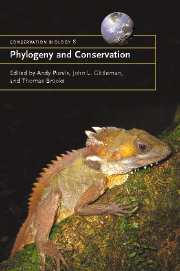Book contents
- Frontmatter
- Contents
- List of contributors
- 1 Phylogeny and conservation
- Part 1 Units and currencies
- Part 2 Inferring evolutionary processes
- Part 3 Effects of human processes
- 12 Conservation status and geographic distribution of avian evolutionary history
- 13 Correlates of extinction risk: phylogeny, biology, threat and scale
- 14 Mechanisms of extinction in birds: phylogeny, ecology and threats
- 15 Primate diversity patterns and their conservation in Amazonia
- 16 Predicting which species will become invasive: what's taxonomy got to do with it?
- Part 4 Prognosis
- Index
- References
16 - Predicting which species will become invasive: what's taxonomy got to do with it?
Published online by Cambridge University Press: 04 December 2009
- Frontmatter
- Contents
- List of contributors
- 1 Phylogeny and conservation
- Part 1 Units and currencies
- Part 2 Inferring evolutionary processes
- Part 3 Effects of human processes
- 12 Conservation status and geographic distribution of avian evolutionary history
- 13 Correlates of extinction risk: phylogeny, biology, threat and scale
- 14 Mechanisms of extinction in birds: phylogeny, ecology and threats
- 15 Primate diversity patterns and their conservation in Amazonia
- 16 Predicting which species will become invasive: what's taxonomy got to do with it?
- Part 4 Prognosis
- Index
- References
Summary
INTRODUCTION
A principal by-product of globalisation is the transport and release of species far outside of their native geographic ranges (Mack et al. 2000). Some of these non-native species may go on to establish self-sustaining populations, and several of these populations will produce significant negative ecological and economic impacts, thus earning the title ‘invasive’ (Pimentel et al. 2000; Davis & Thompson 2000; Daehler 2001). Society's concern over the effects of invasive species has grown as the rate of non-native species establishment has increased hugely over the past decades (Cohen & Carlton 1998; Pimentel et al. 2000; Mack et al. 2000). However, not all non-native species will cause noticeable harm, and fully restricting movement of these species probably requires unacceptable societal costs related to limiting free trade (Van Driesche & Van Driesche 2000). Thus, predicting which species will cause problems out of the many that are transported has become a principal goal of conservation ecologists (Mack et al. 2000). One possible avenue for assigning a species' invasion probability is to assess the predictive power of its taxonomic affiliation (Reichard & Hamilton 1997; Lockwood 1999). This chapter reviews the arguments for using taxonomy as a measure of invasion potential, and the existing evidence showing taxonomic patterns among biological invaders. The final section evaluates the implications of these results in terms of preventing future invaders, and documenting how taxonomic selectivity serves to re-shape future phylogenetic diversity.
- Type
- Chapter
- Information
- Phylogeny and Conservation , pp. 365 - 384Publisher: Cambridge University PressPrint publication year: 2005
References
- 1
- Cited by



